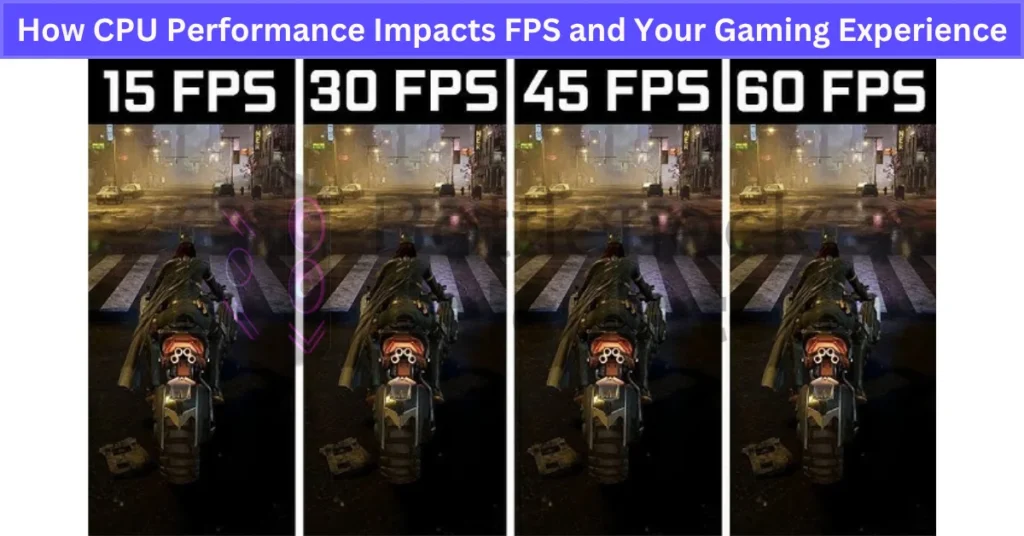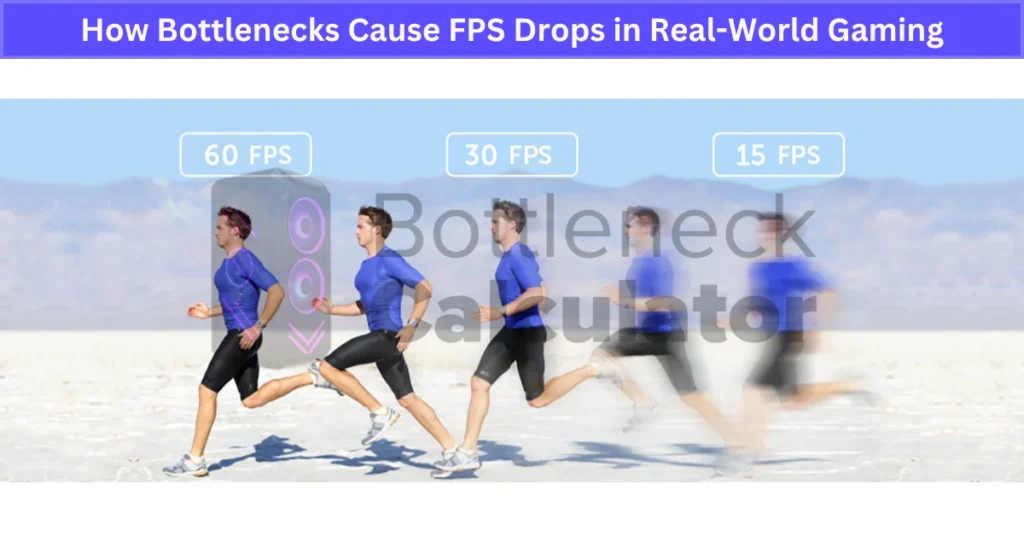How Bottlenecks Can Affect FPS in Popular Games
Last updated:
FPS stands for frames per second. It’s basically how many pictures your game shows every second. Higher FPS means smoother gameplay, making your characters move nice and fluid. If FPS drops in gaming, the game can start to look choppy or laggy, and that really ruins the fun.
A big reason FPS can drop is something called a bottleneck. A bottleneck happens when one part of your computer can’t keep up with the others. Usually, it’s either the CPU or GPU bottleneck causing the slowdown. For example, let’s say you have a powerful GPU like an RTX 4080, but your CPU is older, maybe like a Ryzen 3 3200G.
That weaker CPU could hold back your graphics card, making your FPS way lower than it should be. In games like Cyberpunk 2077, pairing a high-end GPU with a weak CPU can even cause FPS to drop by around 30%. That means your expensive hardware isn’t being used to its full potential.
Gaming hardware balance is really important to get good frame rate performance without wasting money. If one part isn’t good enough, it slows down everything. Imagine trying to run fast while dragging a heavy backpack—it’s kind of like that.
If you’re curious about how your screen resolution can also cause a bottleneck and impact FPS, check out this detailed guide: Can Screen Resolution Cause a PC Bottleneck?.
Later on, I’ll talk more about how bottlenecks mess with your gaming experience, and I’ll give some simple tips for smooth gameplay optimization so you can fix it yourself.
Why FPS Is So Important for Smooth Gaming
FPS, or frames per second, is the base for how smooth and fast your game looks and feels. Without good FPS, games just don’t play right.
- Better Visual Fluidity:
Higher FPS means smoother animations and less stutter. At 30 FPS, games can look slow and a bit choppy—kind of like watching a movie. But 60 FPS is the normal sweet spot for most games. If you want to compete, 120 FPS or more is where it really shines. - Improved Reaction Time:
In games like CS:GO, Valorant, or Call of Duty, quick reactions matter a lot. High FPS helps lower input lag, so your actions happen faster on screen. That can make the difference between winning and losing. - Immersion & Comfort:
Low FPS can cause motion blur and make the game look jumpy. That can tire you out and even make you dizzy, especially in VR or on high-refresh-rate monitors. Consistent FPS helps you stay comfortable and focused.
Pro gamers in esports often aim for 240 FPS on 240 Hz monitors to get the fastest and smoothest gameplay possible. That’s a big advantage if you want to play at the top level.
So honestly, having stable FPS is just as important—maybe even more—than having the fanciest graphics. I’d rather play smooth than have ultra graphics with lag any day.
What FPS Means in Video Games and Why It Matters
FPS means frames per second. It shows how many pictures your game shows on the screen every second. The more frames, the smoother the game feels.
Higher FPS means smooth gameplay. Lower FPS can make the game stutter or lag. That makes it hard to play, especially in fast games.
First-person shooter games like Call of Duty, Halo, and CS:GO need high FPS. When FPS is high, your reactions and aiming get better. That’s why competitive players try to get 120 or 144 FPS or more.
Most games run well at 60 FPS. That’s the common standard. But if you want smoother and faster gameplay, higher FPS helps a lot.
Your monitor’s refresh rate (measured in Hz) works with FPS. A 60 Hz monitor can only show up to 60 FPS. If you have a 144 Hz monitor, it can show up to 144 FPS, making the game look much smoother.

Many esports games even cap FPS at 240 to match 240 Hz monitors for the fastest experience. So, if you want the best gaming feel, use good hardware and pair it with a high-refresh-rate monitor. That combo really makes a difference for smooth gameplay settings.
How CPU Performance Affects FPS in Games
The CPU plays a big role in how many frames per second you get while gaming. It handles the game’s rules and tells the GPU what to do.
Here’s how it works: the CPU processes things like game logic, AI, and player actions. Then it sends this info to the GPU. The GPU takes that and draws the images you see on screen. For smooth FPS, both need to work well together.
But if your CPU is too weak, it can’t keep up. That means the GPU waits around for instructions and can’t run at full power. This causes your FPS to drop. This is called a CPU bottleneck.
Big games like Fortnite or CS:GO use a lot of CPU power for things like physics and player movement. You might see FPS drops even if your GPU isn’t working hard. That’s a sign the CPU is holding things back.

For example, shooters like CS:GO need strong single-core CPU performance to keep 144 FPS or more steady. So having a balanced gaming build is key. If your CPU and GPU don’t match, you’ll get FPS problems and lag.
If you want good FPS optimization, make sure your CPU is up to the task. It’s not just about having a fast GPU—your CPU needs to keep pace too. Otherwise, your gaming won’t be as smooth as it could be.
Types of Bottlenecks That Can Hurt Your FPS in Gaming
A bottleneck happens when one part of your PC slows down the rest. Knowing what kind of bottleneck you have helps fix FPS troubles faster.
CPU Bottleneck
This is when your CPU can’t keep up with the game’s demands. It can’t process game rules or AI fast enough for the GPU. Even if your graphics card is strong, your FPS gets capped.
Example: Games with lots of AI or big worlds like Total War or Planet Coaster often cause CPU bottlenecks.
GPU Bottleneck
Here, your GPU struggles to render all the details, especially at high settings or big screen resolutions. The CPU might be fine, but the GPU slows everything down, dropping FPS.
Example: Playing Cyberpunk 2077 at max graphics or gaming in 4K with a mid-range GPU can cause this.
RAM or VRAM Limitations
Not enough RAM or VRAM causes stutters and FPS dips because the system struggles to load or store game data smoothly.
Example: Running modern games with less than 8GB of RAM or using a GPU with less than 6GB VRAM while maxing out textures can lead to problems.
To figure out what’s really holding you back, try performance monitoring tools. They show if your CPU, GPU, or memory is maxed out during gaming. Fix the right bottleneck, and your FPS will improve for smoother gameplay.
How CPU Performance Impacts FPS and Your Gaming Experience
CPU speed and how well it works matter a lot for FPS in some games. When the CPU is slow or busy, it can hold back your whole system.
The CPU does many jobs in gaming. It handles things like AI (how enemies act), physics (how things move or fall), and game rules. The GPU then takes this info and draws the game on your screen. If the CPU is too slow, it can’t send info fast enough. That makes the GPU wait, which leads to FPS drops and lag.
This wait also causes input lag, meaning your controls feel less responsive. That can be really annoying, especially in fast games.
Games like Red Dead Redemption 2 and The Witcher 3 rely heavily on the CPU. These open-world games have lots of physics and AI going on, so if your CPU isn’t strong enough, you’ll see big FPS drops. On the other hand, games like Metro Exodus depend more on the GPU, so CPU speed matters less there.
The impact of the CPU changes depending on the game. Knowing if your favorite games are CPU-heavy or GPU-heavy can help you avoid buying hardware that won’t fix your FPS problems.

For example, benchmarks show that CPU-bound games can lose 20 to 40 FPS if you pair a powerful GPU with a low-end CPU. That’s a lot of lost smoothness just because your CPU can’t keep up.
So, before upgrading, check if your CPU and GPU work well together and look at gaming performance metrics and game-specific benchmarks. Balancing your hardware saves you from bottlenecks and keeps your gaming smooth.
How Bottlenecks Cause FPS Drops in Real-World Gaming
I’ve seen bottlenecks mess up gaming FPS more times than I can count. When your CPU or GPU can’t keep up, your FPS takes a hit, especially in big, busy game scenes.
Take a CPU bottleneck example. In games like GTA V or Total War, you get lots of AI, big crowds, and open-world events all happening at once. If your CPU is weak, it struggles to handle all that. The result? FPS drops suddenly, and the gameplay feels slow or choppy—even if your GPU isn’t working at full power.
Now, look at a GPU bottleneck. When you play Cyberpunk 2077 or Red Dead Redemption 2 at max graphics on a mid-range GPU, your graphics card can’t keep up with all the details. That means textures load slowly, frames drop, and the game stutters. Even if your CPU is strong, a weak GPU can kill your smooth gameplay.
The best setup is a balanced system, where both CPU and GPU match well. That way, you avoid bottlenecks and get steady high FPS, even in the toughest parts of games.
If you notice sudden FPS drops, stuttering, or slow texture loads, it’s a good idea to check your hardware balance. Using performance tools that show CPU and GPU usage during gameplay can help spot which part is causing trouble.

For example, upgrading from an older Intel i5-7400 to a newer i5-12400 can boost FPS in Total War by about 50%. That’s a big jump just from fixing a CPU bottleneck!
Keep an eye on both CPU and GPU loads to avoid frustrating FPS drops and enjoy smoother gaming.
Games That Get Hit Hard by CPU Bottlenecks
Some games need a lot from your CPU. These are the ones that often slow down when your CPU can’t keep up, causing FPS drops and lag.
Real-Time Strategy (RTS) Games
Games like StarCraft II and Total War: Warhammer make your CPU work hard. Why? Because there are thousands of units on screen, all running their own AI at once. That means the CPU has to think about each unit’s actions during big battles. When this happens, FPS can drop fast because the CPU is overloaded.
Open-World Games
Titles like GTA V and The Witcher 3 also stress the CPU. These games have huge maps with lots of moving characters and changing environments. The CPU has to handle all the background tasks like streaming new parts of the world and managing NPCs. That heavy load can cause your FPS to dip if your CPU isn’t strong enough.
Simulation Games
Games such as Microsoft Flight Simulator and Planet Coaster push the CPU with complex physics and detailed world-building. The CPU has to calculate weather effects, object interactions, and real-time simulations. This intense processing can slow down your FPS if your CPU can’t handle the job.
To avoid frustrating FPS drops in these CPU-heavy games, make sure your processor is up to the task before investing in a new GPU. For example, benchmarks show Total War battles can drop from 60 FPS to 20 FPS if the CPU is the bottleneck. Keeping your CPU and GPU balanced is key to smooth gaming.
How to Check FPS on Your PC
If you want your games to run smooth, it helps to know your FPS. Checking FPS shows how well your computer handles games and helps you spot problems.
Option 1: Use Built-In Game FPS Counters
Many games like CS:GO and Fortnite have settings to show your FPS right on the screen. For example, on Steam, you can turn on the FPS counter by going to Overlay settings. It shows your FPS live while you play, so you don’t have to guess.
Option 2: Use Benchmarking & Monitoring Software
Tools like MSI Afterburner, FRAPS, or GeForce Experience let you track FPS and also show useful info like CPU and GPU usage or temperatures. This helps you find if your CPU or GPU is causing FPS drops or bottlenecks.
Option 3: Windows/Xbox Game Bar
If you have Windows 10 or later, press Win + G to open the Game Bar. It has an FPS counter you can enable easily, so you see your FPS without extra software.
I’d say always check your FPS before and after changing game settings or hardware. That way, you know what really helps your performance.
Quick tip: Enable overlay FPS counters so you can watch FPS in real-time without pausing or leaving your game. It’s super handy for smooth gameplay tuning, especially if you’re using a multi-monitor setup where performance impact can vary between screens.
Pro Tips to Fix Bottlenecks and Boost Your FPS
With a few smart changes, you can cut down bottlenecks and get smoother gameplay. Here’s what I’d try first:
Overclocking
You can safely push your CPU or GPU to run faster than usual. This often gives you extra FPS. But be careful—make sure you have good cooling and follow guides so your system stays stable and doesn’t overheat.
Lowering CPU-Heavy Settings
In games with lots of AI, physics, or big worlds, lower settings like crowd size, draw distance, or AI detail. This helps your CPU handle the game better and can stop FPS drops, especially in open-world or RTS games.
Balancing Resolution and Graphics Settings
Lowering your screen resolution reduces the load on your GPU. Also, lowering textures, shadows, or detail settings helps both your CPU and GPU. Find the sweet spot where the game still looks good but runs smooth.
Hardware Upgrade Advice
Look for the weakest part in your setup—whether it’s CPU, GPU, or RAM—and upgrade that first. Adding an SSD can reduce stutters and load times, and 16GB or more RAM is best for most new games.
Quick tip: After any overclock or upgrade, run stress tests or benchmarks to make sure everything is stable.
Combining these software tweaks with the right hardware upgrades is the best way to reduce gaming bottleneck and boost FPS. I always check CPU and GPU usage with monitoring tools before deciding what to change. It saves money and frustration!
Real User Fixes & Community-Backed Solutions
r/pcmasterrace
A Reddit user clarified what CPU bottlenecking really means, explaining it occurs when the CPU takes longer than the GPU to process frames, causing stutters and reduced performance. They emphasized that mild bottlenecks—where the CPU slightly delays GPU work—usually only yield minor FPS gains if upgraded. The post also highlighted that bottlenecks depend on the specific games and settings, and suggested checking GPU utilization and stuttering as indicators before upgrading the CPU.
Quora
A bottleneck in gaming usually results in lower FPS, stuttering, and prevents your PC from reaching its full potential. It often happens when a weaker CPU limits a powerful GPU or vice versa, causing one component to wait on the other. Other bottlenecks can include PCIe lane limitations or insufficient RAM. Overall, bottlenecks hurt smooth gameplay and responsiveness, making it important to balance system components for optimal performance.
Final Verdict
Bottlenecks happen when one part of your PC—usually the CPU or GPU—can’t keep up with the other. This slows down your FPS and makes games look choppy or laggy. If your system isn’t balanced, even a powerful graphics card won’t give you smooth gameplay.
The best way to avoid bottlenecks is to match your CPU and GPU well and keep an eye on your hardware’s performance. Simple tweaks like lowering settings or upgrading weak parts can boost FPS and make gaming more fun and smooth.
FAQ’s
How does bottleneck affect FPS?
A bottleneck happens when your CPU or GPU can’t handle the game’s demands. This causes your FPS to drop and the game to stutter. When one part falls behind, the whole system slows, making your gameplay less smooth and more frustrating.
What influences FPS the most?
FPS mostly depends on your computer’s hardware. The graphics card and CPU have the biggest impact, but things like GPU memory, RAM, monitor refresh rate, power supply, and cooling also affect how smooth your game runs.

